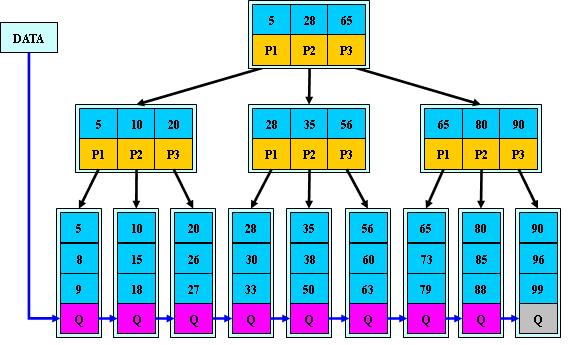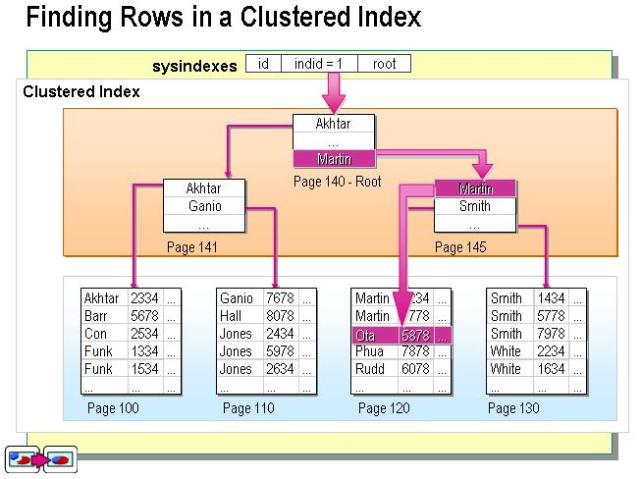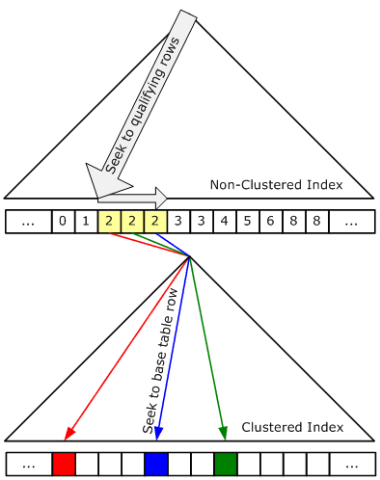聚集索引和非聚集索引以及查询数据的过程 finding rows in a clustered index
不论是 聚集索引,还是非聚集索引,都是用B+树来实现的。我们在了解这两种索引之前,需要先了解B+树。如果你对B树不了解的话,建议参看以下几篇文章:
BTree,B-Tree,B+Tree,B*Tree都是什么
http://blog.csdn.net/manesking/archive/2007/02/09/1505979.aspx
B+ 树的结构图:

B+ 树的特点:
所有关键字都出现在叶子结点的链表中(稠密索引),且链表中的关键字恰好是有序的;
不可能在非叶子结点命中;
非叶子结点相当于是叶子结点的索引(稀疏索引),叶子结点相当于是存储(关键字)数据的数据层;
B+ 树中增加一个数据,或者删除一个数据,需要分多种情况处理,比较复杂,这里就不详述这个内容了。
聚集索引(Clustered Index)
聚集索引的叶节点就是实际的数据页
在数据页中数据按照索引顺序存储
行的物理位置和行在索引中的位置是相同的
每个表只能有一个聚集索引
聚集索引的平均大小大约为表大小的5%左右
下面是两副简单描述聚集索引的示意图:
在聚集索引中执行下面语句的的过程:
select * from table where firstName = 'Ota'

一个比较抽象点的聚集索引图示:

非聚集索引 (Unclustered Index)
- 非聚集索引的页,不是数据,而是指向数据页的页。
- 若未指定索引类型,则默认为非聚集索引
- 叶节点页的次序和表的物理存储次序不同
- 每个表最多可以有249个非聚集索引
- 在非聚集索引创建之前创建聚集索引(否则会引发索引重建)
在非聚集索引中执行下面语句的的过程:
select * from employee where lname = 'Green'

一个比较抽象点的非聚集索引图示:

什么是 Bookmark Lookup
虽然SQL 2005 中已经不在提 Bookmark Lookup 了(换汤不换药),但是我们的很多搜索都是用的这样的搜索过程,如下:
先在非聚集中找,然后再在聚集索引中找。

在 http://www.sqlskills.com/ 提供的一个例子中,就给我们演示了 Bookmark Lookup 比 Table Scan 慢的情况,例子的脚本如下:
USE CREDITgo-- These samples use the Credit database. You can download and restore the-- credit database from here:-- http://www.sqlskills.com/resources/conferences/CreditBackup80.zip-- NOTE: This is a SQL Server 2000 backup and MANY examples will work on -- SQL Server 2000 in addition to SQL Server 2005.--------------------------------------------------------------------------------- (1) Create two tables which are copies of charge:--------------------------------------------------------------------------------- Create the HEAPSELECT * INTO ChargeHeap FROM Chargego-- Create the CL TableSELECT * INTO ChargeCL FROM ChargegoCREATE CLUSTERED INDEX ChargeCL_CLInd ON ChargeCL (member_no, charge_no)go--------------------------------------------------------------------------------- (2) Add the same non-clustered indexes to BOTH of these tables:--------------------------------------------------------------------------------- Create the NC index on the HEAPCREATE INDEX ChargeHeap_NCInd ON ChargeHeap (Charge_no)go-- Create the NC index on the CL TableCREATE INDEX ChargeCL_NCInd ON ChargeCL (Charge_no)go--------------------------------------------------------------------------------- (3) Begin to query these tables and see what kind of access and I/O returns--------------------------------------------------------------------------------- Get ready for a bit of analysis:SET STATISTICS IO ON-- Turn Graphical Showplan ON (Ctrl+K)-- First, a point query (also, see how a bookmark lookup looks in 2005)SELECT * FROM ChargeHeap WHERE Charge_no = 12345goSELECT * FROM ChargeCL WHERE Charge_no = 12345go-- What if our query is less selective?-- 1000 is .0625% of our data... (1,600,000 million rows)SELECT * FROM ChargeHeap WHERE Charge_no < 1000goSELECT * FROM ChargeCL WHERE Charge_no < 1000go-- What if our query is less selective?-- 16000 is 1% of our data... (1,600,000 million rows)SELECT * FROM ChargeHeap WHERE Charge_no < 16000goSELECT * FROM ChargeCL WHERE Charge_no < 16000go--------------------------------------------------------------------------------- (4) What's the EXACT percentage where the bookmark lookup isn't worth it?--------------------------------------------------------------------------------- What happens here: Table Scan or Bookmark lookup?SELECT * FROM ChargeHeap WHERE Charge_no < 4000goSELECT * FROM ChargeCL WHERE Charge_no < 4000go-- What happens here: Table Scan or Bookmark lookup?SELECT * FROM ChargeHeap WHERE Charge_no < 3000goSELECT * FROM ChargeCL WHERE Charge_no < 3000go-- And - you can narrow it down by trying the middle ground:-- What happens here: Table Scan or Bookmark lookup?SELECT * FROM ChargeHeap WHERE Charge_no < 3500goSELECT * FROM ChargeCL WHERE Charge_no < 3500go-- And again:SELECT * FROM ChargeHeap WHERE Charge_no < 3250goSELECT * FROM ChargeCL WHERE Charge_no < 3250go-- And again:SELECT * FROM ChargeHeap WHERE Charge_no < 3375goSELECT * FROM ChargeCL WHERE Charge_no < 3375go-- Don't worry, I won't make you go through it all :)-- For the Heap Table (in THIS case), the cutoff is: 0.21%SELECT * FROM ChargeHeap WHERE Charge_no < 3383goSELECT * FROM ChargeHeap WHERE Charge_no < 3384go-- For the Clustered Table (in THIS case), the cut-off is: 0.21%SELECT * FROM ChargeCL WHERE Charge_no < 3438SELECT * FROM ChargeCL WHERE Charge_no < 3439go


